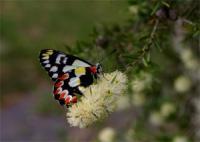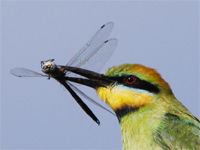“A park with a long history”
The Dja Dja Wrung people are the traditional owners of this land. Little is known of their history on this site. The name of the creek passing through the park, Mia Mia, means shelters. This suggests that, at times, the Dja Dja Wrung dwelt beside it. Just north of Newstead, the Mia Mia Creek joins the Loddon River, “Polodyul Yallock”, which then winds its way north toward the Murray. Waterways were the hunting highways for indigenous people.
After Major Mitchell passed through in 1836, European settlement brought grazing to the district. In the late 1800’s, this area became a park and the Band Rotunda was erected “in the best beauty spot our village can boast” (Newstead Echo 1905). The park has been grazed on and off for more than a century. In 1986, local support preserved the land for use as a park. In the following year, the Rotunda was rebuilt.
Endangered vegetation type
Mining, farming and woodcutting have altered the native vegetation in the district especially along rivers, creeks and on low-lying flats. However, this park still has good examples of endangered native vegetation communities once widespread on creeklines and river flats. We are enhancing this precious remnant by planting local grasses, shrubs and trees.
Big Trees as Habitat
Looking around you will see many large old trees. Only old eucalypt trees have hollows large enough for nesting. In this area such trees are usually more than 120 years old. Birds and small mammals, like Sugar Gliders (pictured), need large trees and hollows to survive. In some of the trees, you will see some nesting boxes. These were made by students of Newstead Primary School to increase the number of “homes” available.
Large eucalypt trees produce lots of nectar. Nectar-feeding birds such as the Regent Honeyeater and the Swift Parrot need these trees. Both are endangered and have been found in the Newstead area. You may see native bees and various honeyeaters visiting the flowers of the trees. Many native mammals also feed on this nectar.
Trees in this area grow 3-5 mm diameter per year. How old could the largest tree in the park be? (Measure at the height of your chest).
Dead wood has life
Whether the dead wood is lying on the ground, or still standing as a tree, it is important habitat. Dead wood provides food and shelter for many animals, such as lizards, frogs, birds, echidnas, worms and insects. When fungi, termites, ants and other insects break down the wood, this enriches the soil. Dead wood is part of the cycle of life.
Some species once common in our area have gone. In the 1970s the distinctive wailing of the Bush Stone Curlew could be heard at night. These birds nested on the ground and hunted amongst the dead wood. Removal of fallen branches and bark exposes ground dwellers and their nests to introduced predators such as cats, dogs and foxes.
Trees are not the only important plants
Understorey plants are those that grow beneath the trees. They include shrubs, grasses and other small plants. These plants provide food and shelter for insects, birds, reptiles and mammals. For example, wattles provide food for Sugar Gliders and pollen for insects. Insects become food for birds, such as the Silvereye (pictured), bats and other small native mammals. The prickles of hedge wattles provide protection for the nests of small birds like Thornbills and Blue Wrens. Understorey plants also reduce erosion.
There are many native grasses in the park. Native grasses provide food and shelter for many native animals. The deep roots of these grasses help them survive hot, dry summers. They also reduce salinity. In summer Kangaroo Grass has orange seed heads (pictured). See if you can find some.
Newstead’s Landcare Group and Primary School have planted understorey plants in the park. Along the edge of the creek, we have planted tussock grasses, sedges and bottlebrushes to reduce erosion.
Together we are restoring the “best beauty spot our village can boast of” for all its native inhabitants and for us all to enjoy.
Newstead Landcare Group 2004












Pingback: Outside the Garden Gate – in the garden
Love this site and many thanks for sharing your insights.